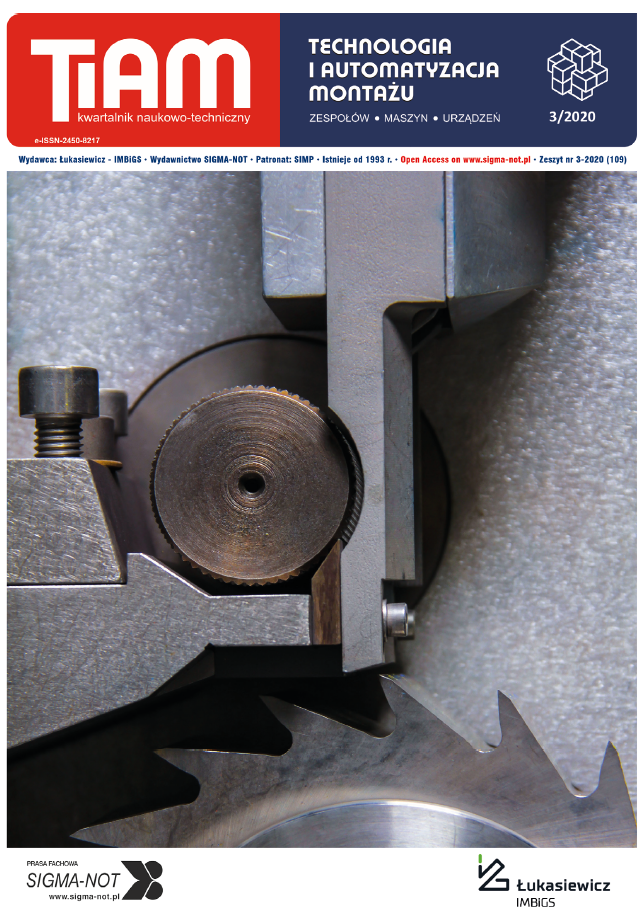Abstract
Friction stir welding (FSW) is one of the most modern methods of joining metals and their alloys in a solid state. This method is particularly suitable for joining the materials that are difficult to weld, such as steels and high-strength aluminum, copper and titanium alloys, as well as some nickel, zirconium and copper alloys. It makes it possible to use this method in the production of aviation structures while reducing the labour consumption, cost and weight, while maintaining comparable or higher strength parameters compared to classic methods. However, the face of weld made using the FSW method is often uneven and moreover, the welding process itself introduces tensile stresses in the surface layer, which reduces the fatigue strength of the joints. Brushing is one of the methods of removing the welding burrs. The study investigates the effect of brushing treatment on the selected properties of the surface layer of butt welds of 2024-T3 aluminum alloy. The research was carried out with the use of wire brushes and cutting brushes with ceramic fibers. The analysis of the obtained results showed that brushing with using a wire brush at a feed rate of 70 mm/min (variant 1) introduced the most favorable residual stresses, while brushing with a ceramic brush at a feed rate of 100 mm/min (variant 4) provided the lowest roughness parameters.
This is an Open Access article distributed under the terms of the Creative Commons Attribution License CC BY 4.0 (https://creativecommons.org/licenses/by/4.0/)
References
Bonarski J. 2013. Measurement and use of the texture- stress microstructure characteristics in materials diagnostics. Cracow: Institute of Metallurgy and Materials Science of the Polish Academy of Sciences.
Buffa G., Fratini L., Micari F. 2012. "Mechanical and microstructural properties prediction by artificial neural networks in FSW processes of dual phase titanium alloys”. Journal of Manufacturing Processes 14(3): 289-296. https://doi.org/10.1016/j.jmapro. 2011.10.007
Cao J. Y.,Wang M., Kong L., Zhao H.X., Chai P. 2017. “Microstructure, texture and mechanical properties during refill friction stir spot welding of 6061-T6 alloy”. Materials Characterization 128:54–62. https:// doi.org/10.1016/j.matchar.2017.03.023
Khodaverdizadeh H., Mahmoudi A., Heidarzadeh A., Nazari E. 2012. "Effect of friction stir welding (FSW) parameters on strain hardening behavior of pure copper joints”. Materials & Design 35: 330-334. https:// doi.org/10.1016/j.matdes.2011.09.058
Kluz R., Bucior M., Kubit A. 2019. ''Identifying optimal Friction Stir Welding process parameters for 2024 Al alloy butt joint". Advances in Science and Technology-Research Journal 13(4): 48-53. https:// doi.org/10.12913/22998624/110740
Kłysz S. 2015. Basics of strength of materials. Warsaw: Technical Institute of Air Forces.
Kubit A., Bucior M., Wydrzyński D., Trzepieciński T., Pytel M. 2018. „Failure mechanisms of refill friction stir spot welded 7075-T6 aluminium alloy single-lap joints”. Int J Adv Manuf Technol 94:4479–4491. https:// doi.org/10.1007/s00170-017-1176-2
Matuszak J., Zaleski K. 2009. "Effect of technological parameters brushing steel S235JR roughness of the machined surface and the mass of material removed". W Zastosowanie informatyki w inżynierii produkcji, 69-80. Lubelskie Towarzystwo Naukowe. http://bc.pollub.pl/Content/567/PDF/zastosowania. pdf#page=69
Matuszak J., Zaleski K. 2016. Deburring after milling aluminum and magnesium alloys. Lublin: Politechnika Lubelska. http://bc.pollub.pl/Content/12904/PDF/ usuwanie.pdf
Prime M., Gnäupel-Herold T., Baumann J., Lederich R., Bowden D., Sebring R. 2006. “Residual stress measurements in a thick, dissimilar aluminum alloy friction stir weld”. Acta Materialia 54(15): 4013-4021. https://doi.org/10.1016/j.actamat.2006.04.034
Sałaciński T., Pająk P. 2015. "Ceramic tools for surface finish deburring and polishing operations." Mechanik 10: 762-765. https://www.researchgate.net/ publication/282834174_Ceramic_tools_for_surface_ finish_deburring_and_polishing_operations
Shen Z., Chen Y., Hou J.S.C., Yang X., Gerlich A.P. 2015. “Influence of processing parameters on microstructure and mechanical performance of refill friction stir spot welded 7075-T6 aluminium alloy”. Sci Technol Weld Join 20:48–57. https://doi.org/10.1 179/1362171814Y.0000000253
Skrzypek S. 2002. New possibilities of measuring macro stress of materials using X-ray diffraction in the geometry of a constant angle of incidence. Cracow: AGH.
Yang H.G., Yang H.J. 2013. “Experimental investigation on refill friction stir spot welding process of aluminum alloys”. Appl Mech Mater 345:243–246. https:// doi.org/10.4028/www.scientific.net/AMM.345.243


